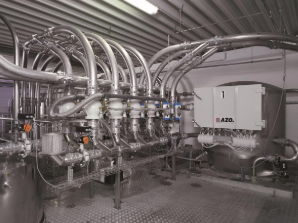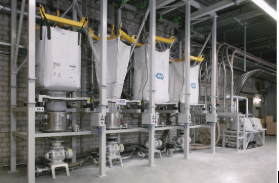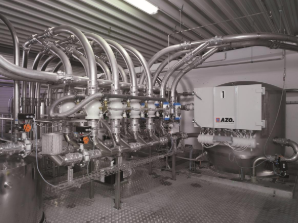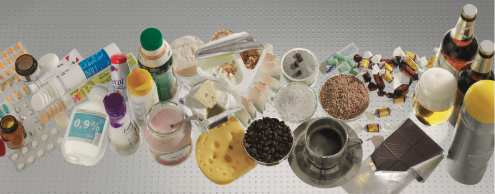
Pneumatic conveying systems are designed to transport materials through a pipe with the use of air or other gas. When it comes to pneumatic conveying from your rail cars, silos or super sack unloading equipment, the choice between pressure and vacuum conveying systems can be as critical as it is entirely situational. Ultimately an engineer will have to consider what is possible with the resources available and which method will best suit the material being conveyed.
Exploring Different Types of Pneumatic Conveying Systems
Safety, efficiency and cost represent just some of the factors to keep in mind when deciding between these two ways of conveying materials. There are specific benefits and disadvantages of each option that pertain to different plant processes.
Big bag stations with vacuum conveying
Let’s start to unravel any conveying conundrums you may face by digging into the benefits of both conveying methods. Then we’ll take a look at specific situational examples you may face conveying with equipment such as rail cars, silos or your own bulk bag unloader:
Why choose vacuum conveying systems?
In most cases vacuum conveying is:
- Cleaner
- Safer
- Efficient
- Flexible
As the rotating device in a pressure blower is located near the entry point of a pressure system, it is possible a glowing ember could enter the conveying line where powders are suspended in the air stream. The presence of oxygen, an ignition source (such as that ember) and fuel can lead to an explosion in this situation. In addition to operators’ safety being jeopardized, reputational damage to a company’s credibility could soon follow. A spark arrester is needed as a means of prevention.
Vacuum systems also lend themselves to a more dust-free operation because they operate below atmospheric pressure. This means that there is no tendency for outward leakage. Keep in mind that it’s of critical importance to keep up with NFPA standards by performing a dust hazard analysis. No matter which vacuum or pressure conveying systems you utilize, you should also identify your material’s explosive characteristics.
Efficiency is the main factor that can turn the tide from vacuum conveying toward pressure, but generally it only becomes less efficient when it is more expensive to vacuum convey. This is essentially when pressure conveying can become a more fitting solution.
Why choose pressure conveying systems?
Two key factors that might call for pressure conveying are:
- Long distance
- High rates
Distance is a limiting factor for vacuum conveying, and once the conveying range is past practical limits, it simply becomes more economical to pressure convey. There are situations in which opting for vacuum conveying becomes overly expensive, and with a high enough rate, there isn’t much of a reason to choose this method. (Example: 400 feet is typically out of range for an affordable vacuum conveying system when the convey rate requirements are also high.)
While there remain many advantages to vacuum conveying (safety, cleanliness and greater flexibility to name a few), essentially there are situations in which you can push something further than you can pull it. Pressure conveying offers the right option for these extreme situations.
Another extreme situation involves a high requirement for resistance to contamination. As vacuum conveying brings air into the system with negative pressure, the only way to certifiably avoid any risk related to unfiltered air or foreign materials entering a convey line through a leak is to use positive pressure in the system. This requirement doesn’t happen often, but for some plants, it remains a prominent concern. (Example: when an application requires an inert gas atmosphere for conveying.)
Still, pressure or vacuum conveying will yield different results in the event that there is a leak in your system.
Leaks in the System
Any small pinhole or loose connection is an opening that can allow dust to blow out of a pressure system, creating undesirable conditions in a factory. If the same hole is found on a vacuum system, air is simply pulled into the system. Product in a vacuum system will not escape the system itself because the pressure on the outside is greater than what is inside.
In the event that you are handling toxic material, this fact becomes essential to minimize the risk of any outward leakage. Opting for a vacuum system is absolutely necessary when the leakage of toxic material is a concern in the process.
AZO vacuum scale with multi-port valve
Air Temperature
One final major benefit to vacuum conveying is that it eliminates the product exposure to heat of compression for the blower outlets.
With pressure conveying, your product may be exposed to the heat of compression. This happens unless a heat exchanger is added to maintain the temperature of ingredients that are being conveyed through a blower.
Specifically, when using vacuum conveying, ambient or conditioned air enters the system in a controlled manner. That air, from the indoor area of a plant, does not add heat to the product being conveyed. With pressure conveying, a blower is used that forces air into a small space and releases it. In doing this, the air becomes hot and there is a risk that degradation can occur in certain ingredients that are temperature-sensitive.
Heat exchangers remedy this concern for temperature-sensitive products in pressure systems, but they do represent an additional piece of equipment for a plant to maintain. There are also extra costs involved, and in a vacuum system, this would not require this equipment.
Still, for non-temperature-sensitive products, the addition of a heat exchanger may be unnecessary — again demonstrating that the choice to use vacuum or pressure conveying can be entirely situational.
Specific situational examples:
Situation #1: Conveying to a mixer or a scale above the mixer by picking up from multiple sources
We recommend: Vacuum conveying
Here’s why: It’s typically cleaner, safer, more efficient and highly flexible.
Situation #2: Filling multiple destinations (silos) from one source: either a super sack/bag dump station, a truck or a rail car
We recommend: Pressure conveying
Here’s why: It would be very expensive to put a separate vacuum receiver above each silo and there is no scaling or weighing involved (It's a simple conveying step “from A to B”).
Situation #3: Scaling to a mixer by picking up from multiple sources (silos or super sacks)
We recommend: Vacuum conveying
Here’s why: It’s typically cleaner, safer, efficient and highly flexible when scaling is involved.
Situation #4: Conveying material across a parking lot from a mill that is 1,200 feet away from a mix plant and silos
We recommend: Pressure conveying
Here’s why: It is far too practical to convey by vacuum. Designing a system with filters, piping and other componentry to be large enough for vacuum conveying at that distance would be incredibly expensive. There would be a large discrepancy between the size of the equipment and the amount of product moving through the system, essentially marking a unique situation where it would be less efficient to vacuum convey.
Situation #5: Conveying at a distance of 500-600 feet with a conveying rate of 300 pounds per minute
We recommend: Pressure conveying
Here’s why: A vacuum system would still be large and expensive in this scenario. The filters would need to be large because of the airflow required. An alternative approach to conveying could be sought out such as putting in an intermediate receiving hopper or “bin” to reduce the distance to the scale or conveying in a step, but unless these options were available, a vacuum system would become costly and not as efficient as a result.
Situation #6: Scaling from one silo to one mixer within 200 feet with a low to moderate rate
We recommend: Vacuum conveying
Here’s why: It’s cleaner, safer, more efficient and flexible when scaling is involved. There is an acceptable conveying distance range for vacuum conveying and the rate is not comparatively high.
No matter what your conveying conundrum, the AZO Inc. team has years of application experience to help with your plant automation challenges. Check out our configurator to discover a wide range of bulk bag discharging products to fit your needs. If there are any options you don’t see listed, contact our sales engineers.





